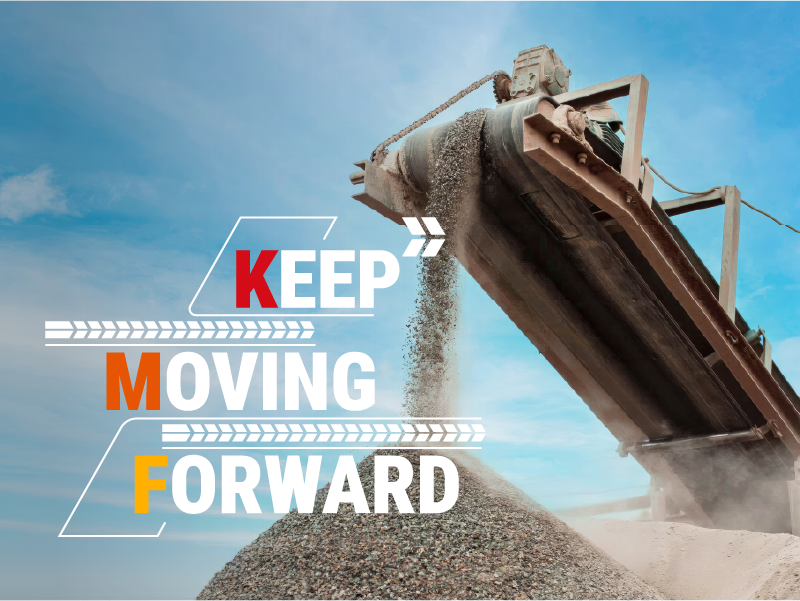A conveying belt is a fundamental piece of equipment used in various industries to transport materials, products, or goods from one place to another efficiently. It consists of a continuous loop or belt, typically made from materials like rubber, fabric, metal, or plastic, which moves along a set of pulleys and rollers to carry items across a defined path. The belt can be flat or equipped with patterns like cleats or chevrons to facilitate the movement of materials, especially in bulk handling applications.
Conveyor belts are crucial in industries such as manufacturing, mining, agriculture, logistics, packaging, and food processing. They streamline production processes, reduce labor costs, and enhance productivity by automating the movement of goods.
Key Components of a Conveying Belt System
- Belt:
- The primary component of a conveyor system, the belt is responsible for physically carrying the materials or products. It can be made from different materials based on the application. Common materials include rubber, PVC, PU (Polyurethane), metal, or fabric.
- The material of the belt will depend on the type of material being transported (e.g., abrasive materials, food products, chemicals), the environment (e.g., wet, dry, high-temperature), and the speed or load capacity requirements.
- Pulleys:
- Pulleys are cylindrical wheels that drive or redirect the conveyor belt’s movement. There are usually two types of pulleys:
- Drive Pulley: The motorized pulley that moves the belt.
- Idler Pulley: These are non-motorized pulleys that help in guiding the belt, ensuring it maintains its proper path along the conveyor system.
- Rollers:
- Rollers support the belt and allow it to move freely across the conveyor. They reduce friction and distribute the weight of the transported materials evenly. These rollers can be located along the length of the belt and help ensure a smooth and efficient operation.
- Motor and Drive System:
- A motor is used to provide the power required to move the belt. The motor is connected to the drive pulley via a system of gears, belts, or chains. The motor can vary in size depending on the load capacity and speed requirements of the conveyor system.
- Frame:
- The conveyor frame serves as the structure that holds all of the components together. It provides stability to the conveyor system and supports the belt, pulleys, rollers, and other necessary parts.
- Tensioning Device:
- To keep the belt taut and properly aligned, a tensioning device is used. This system adjusts the tension of the belt to prevent slippage and ensure the belt maintains consistent speed during operation.
- Guides:
- Conveyor belts are typically equipped with guide rails or sidewalls to help ensure that materials stay in place during transportation, particularly on inclined conveyors.
Types of Conveyor Belts
Conveyor belts come in many different designs, each suited to specific applications and operational needs. The main types include:
- Flat Belts:
- Flat conveyor belts are the most common type and feature a flat, continuous surface. These belts are widely used in industries where products need to be moved horizontally or with low inclines, such as in assembly lines, packaging, or material handling.
- Cleated Belts:
- Cleated belts are equipped with raised sections (cleats) that help contain materials and prevent slippage, making them ideal for transporting products on inclined planes. The cleats come in various shapes and sizes, depending on the product type and angle of incline.
- Modular Belts:
- These belts are made up of interlocking segments, usually made of plastic or metal, that form a continuous surface. Modular belts offer greater flexibility and can be easily replaced or repaired. They are often used in food processing and packaging industries, where hygiene and versatility are crucial.
- Wire Mesh Belts:
- Made from interwoven metal wires, wire mesh belts are typically used in industries that require high-temperature resistance, such as in the baking, drying, or cooking of food products. The mesh construction allows for air and heat flow, making them ideal for applications that need cooling or heating during transport.
- Chevron Belts:
- As discussed earlier, Chevron conveyor belts are designed with raised V-shaped elements to transport materials on steep inclines. These belts are especially useful in bulk material handling, such as in mining, agriculture, or construction.
- Textile Conveyor Belts:
- Textile belts are primarily used in light and medium-duty applications. These belts consist of woven fabrics (like polyester, nylon, or cotton) and are often used in the transportation of smaller products in manufacturing and logistics.
- Heavy-Duty Conveyor Belts:
- These belts are designed to handle large, heavy, or abrasive materials, such as rocks, coal, and construction debris. Made of durable materials like rubber or steel, heavy-duty conveyor belts are common in mining, quarrying, and construction.
Applications of Conveyor Belts
Conveyor belts are used in a wide variety of industries, including:
- Manufacturing:
- Conveyor belts are commonly used in factories and production lines for automating the movement of goods and parts between workstations. They help streamline assembly processes, reduce manual labor, and increase productivity.
- Mining and Quarrying:
- Conveyor belts are essential in transporting mined materials such as coal, metals, aggregates, and ores from extraction points to processing areas, all while minimizing handling and manual labor.
- Agriculture and Food Processing:
- In agriculture, conveyor belts are used to move crops, such as grains, fruits, and vegetables, from farms to processing plants. In food processing, they help transport raw ingredients or packaged products along production lines.
- Logistics and Warehousing:
- Conveyor belts are commonly used in warehouses and distribution centers to move products between sorting, packing, and shipping stations. They help optimize warehouse operations, reducing time and labor costs.
- Packaging:
- In packaging operations, conveyor belts are used to move products through various stages, such as sorting, labeling, and wrapping. This helps in maintaining a steady production flow and ensuring products are handled efficiently.
- Airport Baggage Handling:
- Conveyor belts are used extensively in airports to transport luggage and cargo. Baggage claim areas are equipped with belts that move passengers’ luggage from the airplane to the baggage claim area efficiently.
Advantages of Conveyor Belts
- Efficiency and Automation:
- Conveyor belts reduce the need for manual labor, leading to higher efficiency and automation. This results in faster processing times, increased throughput, and fewer errors.
- Consistent and Continuous Transport:
- Conveyor belts provide continuous transport of materials, reducing downtime and ensuring a steady flow of goods, which is vital for high-volume production or material handling.
- Reduced Labor Costs:
- Automation through conveyors minimizes the need for workers to manually carry or move products. This leads to cost savings in labor and the potential for reallocating workforce to other tasks.
- Flexibility:
- Conveyor systems can be customized to meet the needs of different industries and applications. They can handle various types of materials, such as bulk, packaged goods, or fragile items, and be designed for different inclines and lengths.
- Improved Safety:
- By automating the movement of materials, conveyor belts reduce the physical strain on workers and lower the risk of injuries associated with manual lifting and carrying.
- Energy Efficient:
- Modern conveyor belts are designed to be energy efficient, reducing the power required to move materials compared to other mechanical handling systems.



